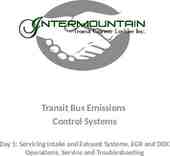Data Warehousing Tanvi Madgavkar CSE 7330 FALL 2009
25 Slides268.18 KB
Data Warehousing Tanvi Madgavkar CSE 7330 FALL 2009
What is Data Warehousing? Ralph Kimball states that : A data warehouse is a copy of transaction data specifically structured for query and analysis.
What is Data Warehousing? Bill Inmon states that : A warehouse is a subject-oriented, integrated, time-variant and non-volatile collection of data in support of management's decision making process.
Advantages of Data Warehousing A data warehouse provides a common data model for all data of interest regardless of the data's source. Prior to loading data into the data warehouse, inconsistencies are identified and resolved. The information in the warehouse can be stored safely for extended periods of time.
OLTP It is a short for On Line Transaction Processing. OLTP refers to a class of systems that facilitate and manage transaction-oriented applications, typically for data entry and information retrieval. It is characterized by a large number of short on- line transactions. The main emphasis for OLTP systems is put on very fast query processing in multi-access environments.
OLAP It is a short for On Line Analytical Processing. OLAP is an approach to quickly answer multi- dimensional analytical queries. The term OLAP was created as a slight modification of the traditional database term OLTP. It is characterized by relatively low volume of transactions.
OLAP v/s OLTP In general, OLTP systems provide source data to data warehouses, whereas OLAP systems help to analyze it. OLTP OLAP Source of data OLTPs are the original source of data Data comes from various OLTP databases Purpose of data To run fundamental transaction related tasks To help with planning and decision support Queries Standardized and simple queries Complex queries involving Aggregation Processing Speed Very Fast Depends on the amount of data involved Space Requirements Relatively small Larger due to existence of historical data
Types of OLAP Multidimensional OLAP - MOLAP This is the more traditional way of OLAP analysis. In MOLAP, data is not stored in the relational database but in a multidimensional cube. Relational OLAP - ROLAP It works directly with relational databases, the base data is stored as relational tables and new tables are created to hold the aggregated information. Hybrid OLAP - HOLAP HOLAP attempt to combine the advantages of MOLAP and ROLAP. Here, a database will divide data between relational to hold the larger quantities of detailed data and specialized storage for smaller quantities of less-detailed data.
OLAP Process Steps in OLAP creation process:
OLAP cube OLAPs are designed to give an overview analysis of what happened. Hence the data storage has to be set up differently. OLAP cubes also called a multidimensional cube or a hypercube data models. and are created from OLAP cubes are not strictly cuboids - it is the name given to the process of linking data from the different dimensions.
There can be number of cubes, developed along units of dimensions or a giant cube can be formed with all the dimensions. The OLAP cube is present at the core of any OLAP system and consists of number of tables arranged in a particular schema. The cube metadata is typically created from either a star schema or snowflake schema of tables in a relational database.
Star Schema The most common method is called the star design and it is called so, because it resembles a ‘star’ in shape. The star schema also known as star join schema is the simplest style of data warehouse schema. The star schema consists of a few fact tables, normally possibly only one, justifying the name referencing number of dimension tables.
Model of Star Schema
Create Table FACT1 (time key INTEGER, item key INTEGER, branch key INTEGER, Location key INTEGER, PRIMARY KEY (time key)) Create Table TIME (time key INTEGER, day VARCHAR(10), month VARCHAR(10), year VARCHAR(10), day of work VARCHAR(10), quarter VARCHAR(10), FOREIGN KEY time key REFERENCES FACT1) Create Table BRANCH (time key INTEGER, branch key INTEGER, branch name VARCHAR(10), branch type VARCHAR(10), FOREIGN KEY time key REFERENCES FACT1)
Advantages: Simplest DW schema. Easy to understand. Easy to Navigate between the tables due to less number of joins. Most suitable for Query processing. Disadvantages: Occupies more space. Highly Denormalized.
Snowflake Schema A snowflake schema is a logical arrangement of tables in a multidimensional database such that the entity relationship diagram resembles a snowflake in shape. It is closely related to star schema as it is just a variation of it. The only difference being that dimensions are normalized into multiple related tables in a snowflake schema whereas the star schema's dimensions are denormalized with each dimension being represented by a single table.
Model of Snowflake Schema
Create Table FACT1 (time key INTEGER, item key INTEGER, branch key INTEGER, Location key INTEGER, PRIMARY KEY (time key))) Create Table ITEM(time key INTEGER, item key INTEGER, item name VARCHAR(10), brand VARCHAR(10), type VARCHAR(10) , supplier type VARCHAR(10) FOREIGN KEY time key REFERENCES FACT1) Create table SUPPLIER (time key integer, supplier key integer, supplier type integer) FOREIGN KEY time key REFERENCES FACT1)
Create Table FACT1 (time key INTEGER, item key INTEGER, branch key INTEGER, Location key INTEGER, PRIMARY KEY (time key))) Create Table LOCATION(time key INTEGER, location key INTEGER, street VARCHAR (10), city VARCHAR(10), KEY(location key) FOREIGN KEY time key REFERENCES FACT1) PRIMARY Create table CITY (location key INTEGER, city key INTEGER, country VARCHAR (10), city VARCHAR (10), state VARCHAR (10))s FOREIGN KEY location key REFERENCES LOCATION)
Advantages: These tables are easier to maintain. Saves the storage space. Disadvantages: Due to large number of joins it is complex to navigate.
Star v/s Snowflake Star schema is a better option to choose from users point of view. This schema exposes users to the underlying table structures and also the queries are simpler in nature. It is more likely to be used when the data warehouse is large. Snowflake schema are often better with more sophisticated query tools and smaller data warehouse. Even though its maintenance is relatively easy, it is based on environments having numerous queries with complex criteria and hence more query execution time.
Questions?
Bibliography W.H. Inmon. “What is a Data Warehouse?, Prism, Volume 1, Number 1, 1995”. Ralph Kimball. “The Data Warehouse Toolkit: Practical Techniques for Building Dimensional Data Warehouses”. Jun Yang. “WareHouse Information Prototype at Stanford”. C. Caldeira. "Data Warehousing – Concepts and Models". RainMaker DataWarehousing. “OLAP vs OLTP.pdf”, http://www.rainmaker works.com/pdfdocs/OLTP vs OLAP.pdf “Data Warehousing: A look at Business Intelligence and Data Warehouse”, http://www.1keydata.com/dataware housing/ molap-rolap.html Hari Mailvaganam. “ Data Warehousing Review – Introduction to OLAP”, http://www.dwreview.com/OLAP /Introduction OLAP.html Mri Sonam. “What is the difference between star schema and snow flake schema?”, http://www.geekinterview.com/question details/38599 Wikipedia, The Free Encyclopedia. “Data Warehouse, OLAP, OLTP, Star Schema, Snowflake Schema”, http://en.wikipedia.org/wiki/Main Page






























